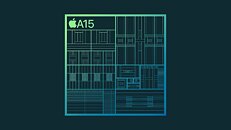TheLostSwede
News Editor
- Joined
- Nov 11, 2004
- Messages
- 18,045 (2.44/day)
- Location
- Sweden
| System Name | Overlord Mk MLI |
|---|---|
| Processor | AMD Ryzen 7 7800X3D |
| Motherboard | Gigabyte X670E Aorus Master |
| Cooling | Noctua NH-D15 SE with offsets |
| Memory | 32GB Team T-Create Expert DDR5 6000 MHz @ CL30-34-34-68 |
| Video Card(s) | Gainward GeForce RTX 4080 Phantom GS |
| Storage | 1TB Solidigm P44 Pro, 2 TB Corsair MP600 Pro, 2TB Kingston KC3000 |
| Display(s) | Acer XV272K LVbmiipruzx 4K@160Hz |
| Case | Fractal Design Torrent Compact |
| Audio Device(s) | Corsair Virtuoso SE |
| Power Supply | be quiet! Pure Power 12 M 850 W |
| Mouse | Logitech G502 Lightspeed |
| Keyboard | Corsair K70 Max |
| Software | Windows 10 Pro |
| Benchmark Scores | https://valid.x86.fr/yfsd9w |
Say what you want about Apple's ARM based SoC's, but the company has been pushing the envelope almost every time they've released a new chip. However, this year it would seem that even Apple isn't particularly excited about its new SoC, as the A15 Bionic is only described as 50 percent faster than the nearest competitor, which doesn't really say much about the actual performance.
Likewise, the improved GPU in the A15 Bionic is being touted as offering 30 percent faster graphics than leading competition, which says nothing about how much of an improvement it is over the previous generation from Apple. This time around, Apple is also binning its chips based on working GPU cores, as the iPhone 13 and iPhone 13 mini only get four GPU cores, whereas the iPhone 13 Pro, iPhone 13 Pro Max and the iPad mini gets five GPU cores.It's possible that the cost of manufacturing 5 nm chips has something to do with this.




So what about the devices? Well, the iPhone 13 and iPhone 13 mini have both been upgraded to 128 GB for the base SKU, which should please a lot of people. The iPhone 13 carries over the displays from the iPhone 12 and as such gets a 6.1-inch OLED display with a resolution of 2532x1170 pixels and 460 ppi, whereas the iPhone 13 mini gets a 5.4-inch OLED display with a slightly lower resolution of 2340x1080 and 476 ppi. However, Apple has upped the max brightness from 625 nits to 800 nits, although both models still top out at 1200 nits in HDR mode.
With the iPhone 13, Apple went from a stacked camera lens placement to a vertical one, although we're still looking at a pair of 12MP cameras, but Apple claims to be using improved sensors in both cameras, even though that's not really reflected in the specs. The main camera sports sensor shift stabilisation, which should reduce shaky video and blurry pictures.
As with the iPhone 12, the iPhone 13 supports 5G, but Apple has added support for more 5G bands and more carriers around the world. Apple also claims to have improved battery life by 2.5 and 1.5 hours respectively for the iPhone 13 and iPhone 13 mini, all of which is attributed to the A15 Bionic being more efficient. The iPhone 13 mini starts at US$699, with the iPhone 13 starting at US$799.
The iPhone 13 Pro and iPhone 13 Pro Max have been given a slightly bigger overhaul and beyond the new SoC mentioned above, we're looking at what Apple calls "ProMotion" technology, which is adaptive screen refresh rates of 10-120 Hz. The screens of both models have also had the max brightness improved from 800 nits to 1,000 nits.



As for the cameras, Apple has once again incorporated improved sensors and this time around the "telephoto" camera has been given 3x optical zoom. The wide and ultra wide cameras have had their aperture improved slightly as well. Apple has also added its proprietary ProRes video codec to the iPhone 13 Pro and iPhone 13 Pro Max, although it's "limited" to 4K30p.
As with the iPhone 13, the iPhone 13 Pro and iPhone 13 Pro Max have gained 1.5 and 2.5 hours of extra battery life over their predecessors. Price wise, you're looking at a base price of US$999 for the iPhone 13 Pro, with the iPhone 13 Pro Max starting at US$1,099. Both models now also come in a 1 TB SKU, which in the case of the iPhone 13 Pro Max would set you back US$1,599.
View at TechPowerUp Main Site
Likewise, the improved GPU in the A15 Bionic is being touted as offering 30 percent faster graphics than leading competition, which says nothing about how much of an improvement it is over the previous generation from Apple. This time around, Apple is also binning its chips based on working GPU cores, as the iPhone 13 and iPhone 13 mini only get four GPU cores, whereas the iPhone 13 Pro, iPhone 13 Pro Max and the iPad mini gets five GPU cores.It's possible that the cost of manufacturing 5 nm chips has something to do with this.




So what about the devices? Well, the iPhone 13 and iPhone 13 mini have both been upgraded to 128 GB for the base SKU, which should please a lot of people. The iPhone 13 carries over the displays from the iPhone 12 and as such gets a 6.1-inch OLED display with a resolution of 2532x1170 pixels and 460 ppi, whereas the iPhone 13 mini gets a 5.4-inch OLED display with a slightly lower resolution of 2340x1080 and 476 ppi. However, Apple has upped the max brightness from 625 nits to 800 nits, although both models still top out at 1200 nits in HDR mode.
With the iPhone 13, Apple went from a stacked camera lens placement to a vertical one, although we're still looking at a pair of 12MP cameras, but Apple claims to be using improved sensors in both cameras, even though that's not really reflected in the specs. The main camera sports sensor shift stabilisation, which should reduce shaky video and blurry pictures.
As with the iPhone 12, the iPhone 13 supports 5G, but Apple has added support for more 5G bands and more carriers around the world. Apple also claims to have improved battery life by 2.5 and 1.5 hours respectively for the iPhone 13 and iPhone 13 mini, all of which is attributed to the A15 Bionic being more efficient. The iPhone 13 mini starts at US$699, with the iPhone 13 starting at US$799.
The iPhone 13 Pro and iPhone 13 Pro Max have been given a slightly bigger overhaul and beyond the new SoC mentioned above, we're looking at what Apple calls "ProMotion" technology, which is adaptive screen refresh rates of 10-120 Hz. The screens of both models have also had the max brightness improved from 800 nits to 1,000 nits.



As for the cameras, Apple has once again incorporated improved sensors and this time around the "telephoto" camera has been given 3x optical zoom. The wide and ultra wide cameras have had their aperture improved slightly as well. Apple has also added its proprietary ProRes video codec to the iPhone 13 Pro and iPhone 13 Pro Max, although it's "limited" to 4K30p.
As with the iPhone 13, the iPhone 13 Pro and iPhone 13 Pro Max have gained 1.5 and 2.5 hours of extra battery life over their predecessors. Price wise, you're looking at a base price of US$999 for the iPhone 13 Pro, with the iPhone 13 Pro Max starting at US$1,099. Both models now also come in a 1 TB SKU, which in the case of the iPhone 13 Pro Max would set you back US$1,599.
View at TechPowerUp Main Site










 Have phone with your iSpy device then.
Have phone with your iSpy device then.